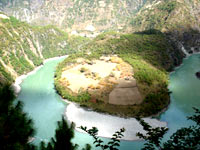| Tools: Save | Print | E-mail | Most Read |
| China Vows to Enhance Protection of World Heritage Sites |
| Adjust font size: |
Chinese cultural and natural heritage sites, which have been recognized by the United Nations Educational, Scientific and Cultural Organization (UNESCO) since 1987, include the Zhu Yujie, an official of UNESCO's world heritage project, said enhanced protection of the world's natural and cultural heritage was of crucial importance. These sites had high historic, cultural and scientific value, and the government had worked hard for their protection, Zhu said. However, the sites had met with many problems such as natural disasters, over-exposure to human activities and pollution. "It will be a huge and long-term task to protect and manage them properly," he said. During the one-day world heritage protection forum held at The vice curator of Beijing's Palace Museum Zhou Suqin said experts were using modern technologies, such as liquid injection in wall repair and three-dimensional digital exhibition, to repair and protect the 600-year old imperial palace. The Convention on the Protection of World Cultural and Natural Heritage, which UNESCO adopted in 1972, requires all its members to preserve and safeguard listed sites, which are protected during times of war. Candidate cultural sites are required to have historic, artistic, archeological scientific and anthropological value, while natural sites must offer distinct ecological and geographical features. The sites were: (Xinhua News Agency December 4, 2006)
|
| Tools: Save | Print | E-mail | Most Read |
 |
| Related Stories |
|
Product Directory China Search |
Country Search Hot Buys |
